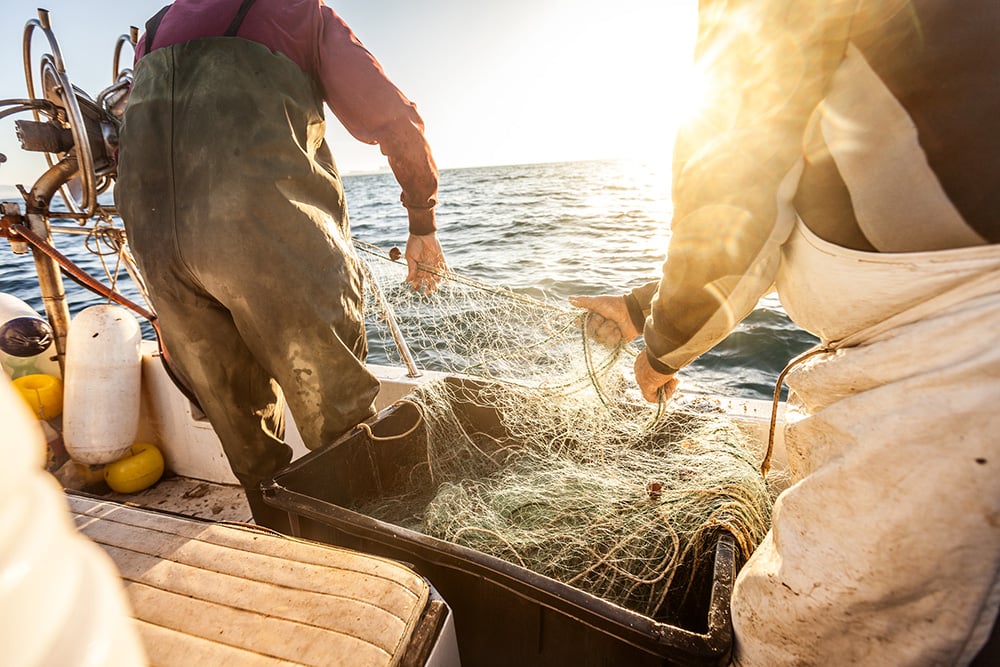
Around half of all seafood in the world is produced from aquaculture, essentially the farming of species like salmon and mussels in sea pens or on ropes for human consumption. With wild stocks of fish in many cases under so much fishing pressure, farming offers a sustainable solution to feed a growing population. Our range of farmed seafood includes more than 10 species at any one time with salmon, trout, mussels, prawns and oysters the most popular among our customers.
Working with Compassion in World Farming, we have improved and relaunched our policy for sustainable fish sourcing. This now includes a step change in policy to prioritise sustainable sourcing, and include distinct supplier requirements related to raw material traceability, Illegal, Unregulated, Unreported (IUU) fishing risk management and welfare reporting obligations within aquaculture.
Fuller details on our fish welfare standards can be accessed through our Farm Animal Welfare Report here.
Standards
As with the farming of any livestock, high operational standards are important to ensure:
Quality and safety of products
Environmental impact of the operations
Safety of the workers
Welfare of fish
Three major aquaculture standards underpin our approach to sourcing, all of which have been recognised by the Global Sustainable Seafood initiative. We require certification to one of these standards throughout the whole supply chain; processor, farm, hatchery and feed mill, to ensure the integrity of standards throughout production.
Welfare
Animal welfare consistently ranks among the highest concerns of our customers in our Corporate Responsibility survey. We recognise that fish, like other animals, are sentient, capable of feeling pain and a range of emotions. With this in mind we engage with industry and standards bodies to ensure that as management practices and systems develop they do so with the welfare of fish put first. Not just for the benefit of the fish, but happier fish grow up healthier and produce better quality products for our customers.
Our sourcing policy defines key welfare requirements for species above and beyond the standards which underpin our approach to farmed sourcing. This includes requirements for stunning before slaughter for key species like salmon, trout, bass, ream and pangasius and specific requirements related to factors like staff training, stocking density, use of medicines, feed quality, handling and fasting to ensure the welfare of fish is made a priority at all stages of production.
We continue to work with our key suppliers to develop systems to track specific farm performance data to improve our oversight in this area. Click here to for more information and to access our latest Farmed Animal Health and Welfare report.
Feed
Many species of fish and seafood reared in aquaculture systems are carnivorous so growing global aquaculture production places stress of wild populations of forage fish, like anchovies, whiting and menhaden that are used in feed.
While production systems for species like salmon are incredibly efficient at converting feeds made from smaller species into palatable species for human consumption, it is important these smaller fish are sourced in a sustainable manner to ensure stocks are not depleted for other wild fish. As such, we are working towards an ambition for all our species used in our fish feeds to be certified to the International Fishmeal and Fish Oil Responsible Sourcing standard, or demonstrably complaint with our wild capture sourcing policy.
More broadly we recognise the need for aquaculture to reduce its dependency on these species in order to sustainably grow and support the development and trial of alternative feeds.

Labelling
All our fish or seafood produced from farmed systems is clearly labelled on the front of pack with our ‘responsibly farmed’ logo so customers know how it has been produced.

Transparency
Information on the sources and production standards for our farmed fish and seafood can be found through our submission to the Ocean Disclosure Project which is updated each year; click here to visit their site.